Based on the lessons of the Hanshin-Awaji Earthquake, the road management organizations in regions where earthquake countermeasures are being strengthened, particularly in Shizuoka prefecture where the risk of a Tokai earthquake is the greatest (henceforth referred to as the “Tokai” region), established a joint group to look at this issue. The purpose of this group was to consider how road management organizations can efficiently secure emergency transport routes by sharing information about damages to road in the immediate aftermath of an earthquake.
Information sharing between different road management organizations is not simple as it must deal with the different disaster response systems that each organization has established independently. Having been involved in the support of this joint group since 1995, I will describe in this report one approach to solving this problem by utilizing GIS.
2. Problems with Sharing Information Between Different Organizations
The organizations involved in managing the road system in the Tokai region are the Ministry of Transport, JH, Shizuoka prefecture and the surrounding Kanagawa, Yamanashi, Nagano, Gifu, and Aichi prefectures.
Each of these organizations has its own information systems, including those relating to earthquake response, and no consideration had been given to linking these together. The following issues arise when considering how to exchange information between these systems:
Ø Each organization has its own geographic management information and there is no common base for geographic data.
Ø Each organization has very different methods for managing the location of roads. The Ministry of Construction manages roads based on kilometer marks whereas prefectures manage them based on the road name and lot number.
Ø The prefectural civil defense organization has the central role in the event of an emergency, and while there is communication between road management organizations, the only means for this communication is NTT (Nippon Telegraph and Telephone Corporation) telephone lines. In the event of an earthquake, it is likely that the NTT communication lines will be congested and unavailable.
Ø In the design of each organization’s disaster control related information systems, no consideration has been given to exchanging data with other systems. Links between systems within the same organization are also difficult for the same reason.
Ø As the operational management within each road management organization is based on its own vertical hierarchy, it is difficult to clarify responsibilities for horizontal exchange of information between organizations.
Ø For organizations for which the Tokai region is the only one part of their responsibility, the perceived merit in exchanging information is small.
3. Basic Concepts of Information Exchange
1. Make effective use of GIS for exchanging information between different organizations.
2. Exchange information using multiple different communication networks that are available.
3. Design a system that is applicable to the daily operation of each road management organization.
(1) Making effective use of GIS
Ø Create a digital map that is common to all road management organizations and that can be displayed within each organization as required, enabling geographic information from different organizations to be merged.
Ø Even if the methods used to manage road location information are different for each organization, the location of damage can be identified by all organizations via the common map.
Ø As GIS allows map data to be managed together with associated attribute data, the different road management data held by each organization can be linked as attribute data to the common map, allowing information to be merged.
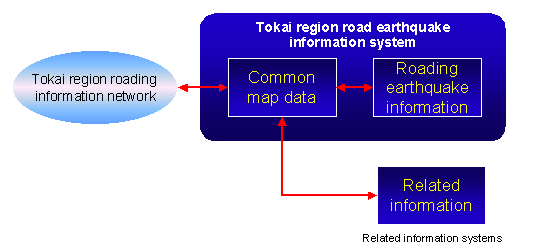
Figure Sharing of Information Based on Common Map Data
(2) Utilize multiple communication networks
(3) Design systems that are applicable to the daily operation of each road management organization
4. Examples of Information Sharing Using the Tokai Earthquake Road Information System
Based on the basic information sharing concepts described above, the “Tokai Earthquake Road Information System” was developed to provide information exchange between the different road management organizations in the Tokai region.
The system was developed in 1998, using Visual Basic 6.0 and Map Objects 2.0 as the GIS engine. An Oracle database is used as the central point for sharing and transferring information between the various organizations. The system provides rapid and reliable information exchange between the different organizations. To enable the system to be installed and expanded easily (cheaply), a Microsoft Access (MDB) database is also available for use on mobile terminals used by mobile patrols and branch offices.
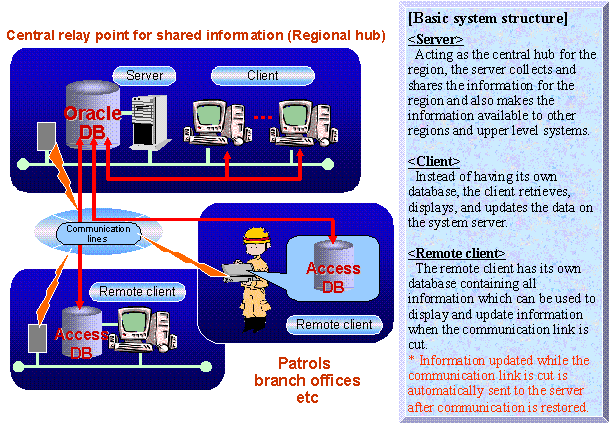
Figure Basic System Structure
(1) Information exchange
1) Traffic control information for normal daily operation (disasters, accidents, roadworks, etc.)
a) Preemptive traffic control due to abnormal weather conditions, snow, or cold
b) When traffic control is performed in response to a disaster caused by abnormal weather conditions, snow, or cold
c) When traffic control operations such as halting traffic is anticipated in response to major traffic accidents or accidents associated with roadworks
d) When traffic control is performed in association with roadworks (including special work)
e) When any other event occurs that requires notification
2) Sharing of earthquake information
a) Earthquake magnitude information for each region
b) Patrol status reports
c) Damage reports
d) Road usability status
e) Status of emergency road restoration
f) Designation of emergency transport routes
(2) Main system functions
1) Updating and sharing traffic control information
Sharing of traffic control information for abnormal weather conditions or roadworks is performed on a daily basis.
By using the system regularly, users will already be familiar with the operation at the time of an earthquake.
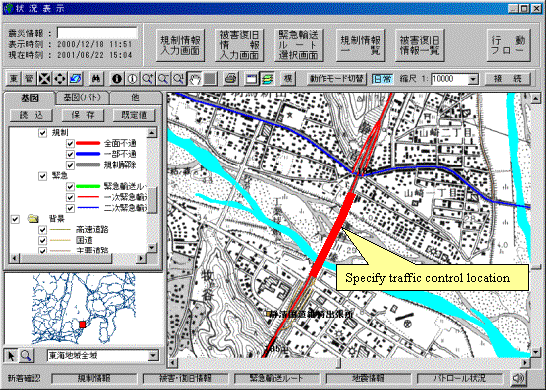 |
Figure Screen for Updating and Viewing Traffic Control Information
2) Updating and sharing damage information
The different road management organizations can share information about damage and restoration of road via the common map.
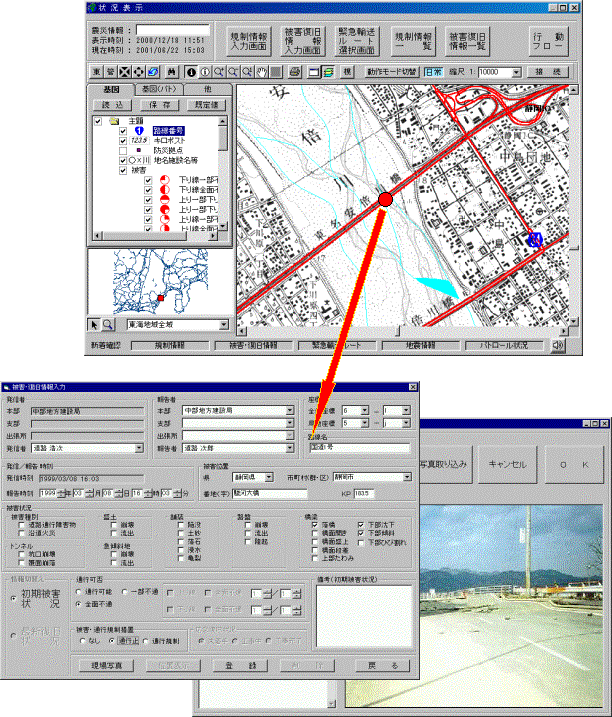
3) Updating and sharing patrol status
The different road management organizations can share and manage the status of patrols in their respective territories.
Shared patrol information from each organization is identified by color, and the progress of each patrol is displayed on the map.
Thick line ... Not checked/Thin line ... Checked
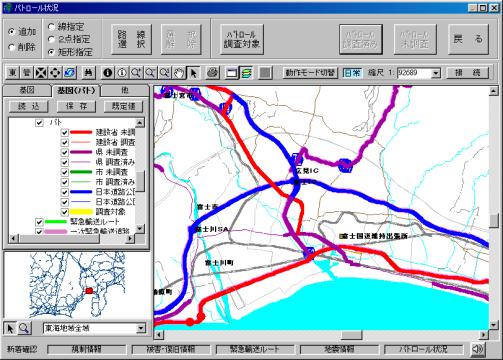
4) Designation and sharing of emergency transport routes
The overall state of the road network can be determined by viewing the damage and restoration information and patrol information shared on the map. This allows optimum emergency transport routes to be quickly designated.
Similarly, when selecting routes, the shared information of damage, restoration and patrol can be taken into account to select the quickest available route on the map.
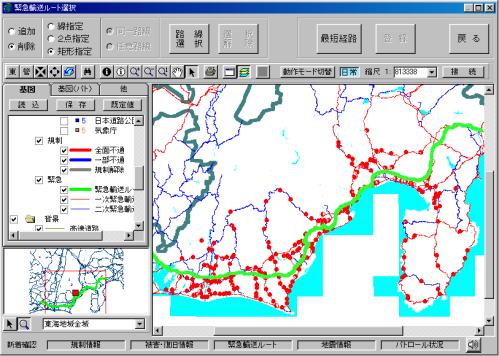
Figure Screen for Designating and Viewing Emergency Transport Routes
(3) System installations
The system is currently installed and operated in the following organizations.
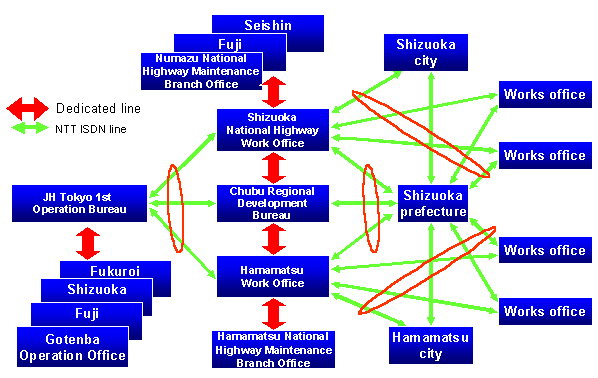
Figure System configuration
(4) Evaluation of system operation
Information sharing between different organizations has been successfully implemented, both in the sharing of traffic control information in normal daily operation and in an exercise carried out on Civil Defense day on September 1st of last year.
However, the civil defense exercise identified the following problems relating to the functions and operations of the system:
Although the system is based on multiple communication lines, it is currently operating on a single line. All offices become isolated when the server located in the Shizuoka prefecture office is shutdown.
Due to the high cost of the NTT line, a long interval (1 hour) has been set between each communication access to the server during daily operation. During the civil defense exercise, however, this meant that information that had been updated on the server did not reach some offices as they had yet to obtain the latest information from the server. To solve this problem, different communication practice between normal and emergency operation needs to be established so that the communication interval is adjustable based on the conditions. Similarly, the system operator needs to fully understand the operation procedures (communication practice) in the event of an earthquake.
5. Future Issues
We have confirmed the practicality of sharing earthquake road information between different organizations based on a common map by trial operation of the system. However, this is not just restricted to earthquake information and we believe that sharing of information relating to road operation between different organizations throughout the entire life cycle, from road operation planning to maintenance management, is important as indicated by the construction CALS concept.
Accordingly, as a new measure aimed at improving the overall efficiency of road management, we intend to proceed with investigating GIS (Road GIS) systems for sharing information about the entire road operation between the different parts of each road management organization and, where necessary, between related organizations.
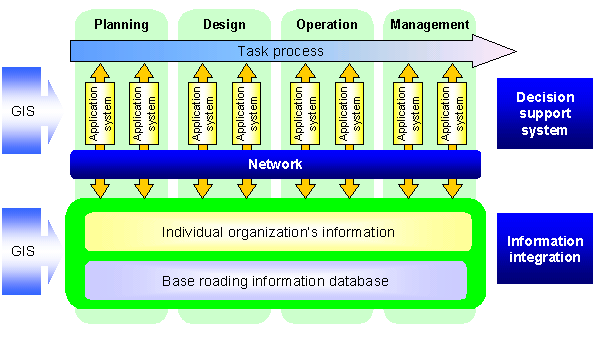
Figure Concept of Road GIS